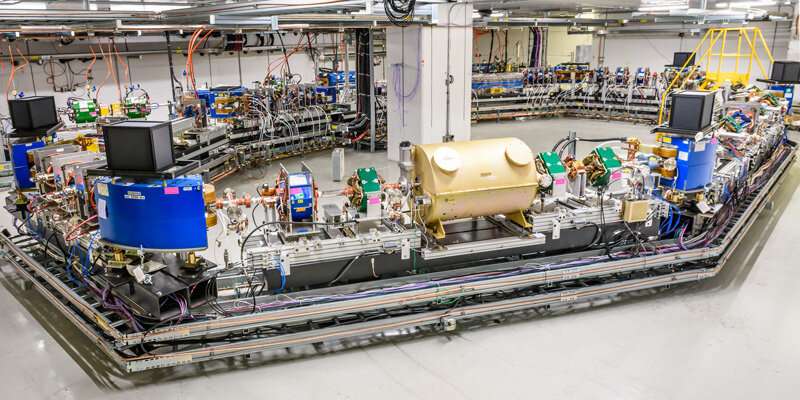Method for determining electron beam properties could help future ultraviolet, X-ray synchrotron light sources

The detected intensity from two coherent point-like light sources depends on their relative positions. It is a well-known phenomenon called optical interference. In general, the intensity can range from zero (destructive interference) to some maximum value (constructive interference).
Consider two high-energy electrons circulating in a particle storage ring, such as the Integrable Optics Test Accelerator at Fermilab. As it was discovered in 1947, when high-energy electrons are forced to travel in a curved path, they emit light, known as synchrotron radiation. If we record the detected synchrotron light intensity at every revolution in a storage ring, we will observe slight fluctuations of its magnitude from turn to turn because the relative positions of the two electrons change.
The IOTA storage ring, hosted by the Department of Energy's Fermilab, can store a billion electrons. Just as in the two-electron case, the turn-to-turn fluctuations of the billion electrons' radiation intensity still exist, and for the same reasons. The fluctuations are very small, below 0.1% (root-mean-square). Still, our research group was able to measure them, and we showed that this information can be used to gain insights into the electron beam's properties, such as its dimensions and divergence—a measure of spread in directions of motion of the electrons in the beam.
The proof-of-principle measurements in IOTA were performed in the near-infrared synchrotron light spectrum range. The sensitivity of this noninvasive method for determining the electron beam properties improves when synchrotron light of shorter wavelength and higher brightness is used. This means it may particularly benefit existing state-of-the-art and next-generation low-emittance high-brightness ultraviolet and X-ray synchrotron light sources, where noninvasive electron beam characterization is difficult.
For instance, we think this method could measure transverse beam sizes on the order of 10 microns in the Advanced Photon Source Upgrade at Argonne National Laboratory, by using the turn-to-turn fluctuations in the X-ray synchrotron light. This is an important step in making tighter electron beams, which in turn generate brighter X-rays. With brighter X-rays, researchers will be able to accelerate research in chemistry, materials science and medicine, including COVID-19 research.
A paper on this result will be published in Physical Review Letters. An expanded companion paper will be published in Physical Review Accelerators and Beams. Corresponding papers "Transverse beam emittance measurement by undulator radiation power noise" and "Measurements of undulator radiation power noise and comparison with ab initio calculations" were published on arXiv.
More information: Transverse beam emittance measurement by undulator radiation power noise. arXiv:2012.00832v3 [physics.acc-ph] arxiv.org/abs/2012.00832
Measurements of undulator radiation power noise and comparison with ab initio calculations. arXiv:2012.00965v3 [physics.acc-ph] arxiv.org/abs/2012.00965
Journal information: Physical Review Letters
Provided by Fermi National Accelerator Laboratory





















